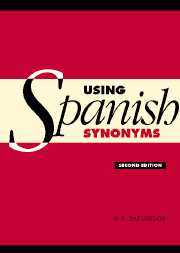Book contents
- Frontmatter
- Contents
- Acknowledgements for the second edition
- List of abbreviations
- Introduction
- Introduction to second edition
- Spanish synonyms
- Index of Spanish items with frame titles
- Index of Argentinian items with frame titles
- Index of Mexican items with frame titles
- Index of English items with frame titles
Introduction
Published online by Cambridge University Press: 05 June 2012
- Frontmatter
- Contents
- Acknowledgements for the second edition
- List of abbreviations
- Introduction
- Introduction to second edition
- Spanish synonyms
- Index of Spanish items with frame titles
- Index of Argentinian items with frame titles
- Index of Mexican items with frame titles
- Index of English items with frame titles
Summary
Word or lexical item
This introduction will use the term “lexical item” instead of “word” which normally designates a single item. “Lexical item” can refer to more than one word, as in the case of arrojar luz and traer a la mente, but it still suggests a unit of meaning for the speaker. The term “lexical item” covers the possibilities of both single-word items and those made up of several words.
Vocabulary acquisition
Vocabulary acquisition is considered to be one of the main methods for absorbing and expressing the variety, richness and creative power of a language. The learner of a foreign language needs to be encouraged to build knowledge around lexical items, to create clusters of words, to develop his/her own lexical fields and to see relationships of meaning between words and expressions. This book of synonyms is intended to promote the building process by showing the learner how to operate exclusively in the foreign language. The ultimate objective is the practical and active exploitation of the target language by the student who is enabled to perceive nuances which differentiate synonyms.
What is a synonym?
Synonyms are terms or expressions which have the same or similar meanings. Since in practice total synonymy hardly ever occurs, the study of synonyms involves the examination of shades of meaning and of how these shades of meaning relate to each other in differences and similarities.
- Type
- Chapter
- Information
- Using Spanish Synonyms , pp. 1 - 6Publisher: Cambridge University PressPrint publication year: 2006



